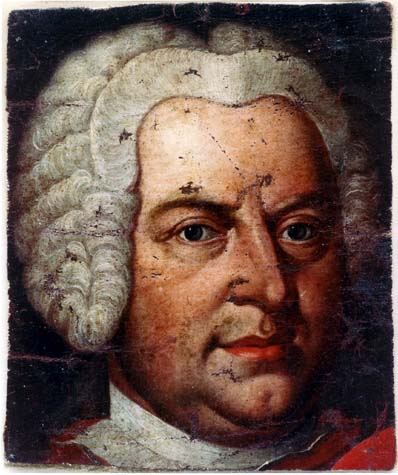The Weydenhammer portrait

[info derived from the description by M. Terri Noel Towe.]
The portrait has been cut out of what must once have been a significantly larger canvas. Fortunately, the portrait fragment, which has suffered some paint loss as well as abrasion and indentation to its surface and which is in some places spotted with what appears to be a light brown grime, has never been restored, although there is one small patch of "in painting" on the right cheek. The canvass and its condition is consistent with fixing the date for the painting at around 1730 to 1735. Where there has been paint loss, the ground (the bolus), made from red clay (common in those days) is visible (this explains the shading).
Despite the loss of paint over the years, the painting is in good condition and the paint is stable. It concerns a portrait in the possession of the familiy Weydenhammer since the 1870's when their ancestor (Edward) emigrated from Leipzig to the USA. The current owners who contacted mr. Nowe about it (in 2000) wrote:
This fragment has been in the family since my mother's family came to this country. I had no idea that portraits of the great man were so scarce. My wish was that somehow the face could be reunited with the rest of the painting if that were extant -- and also to find out something more about it -- the artist?. The family tradition was that it was painted by an ancestor.
Anyway, I think the painting is wonderful and hope you will agree.
Mr. Towe suggests to link this portrait (fragment) to a that once had belonged to Johann Christian Kittel (a student of Bach: 1732-1809). It is described by Ludwig Gerber in 1812 as "ein wohlgetroffenes Oelgemälde von Joh[ann]Sebast[ian]Bach"
[= biographical entry on Johann Christian Kittel in Neues hist.-biogr. Lexikon der Tonkünstler, Vol. 3, col 58. The passage in question tells the story of Kittel's unusual method of rewarding his pupils for having performed well during a lesson: "As a special form of reward and punishment for his pupils [Kittel]used an oil painting of Joh. Sebast. Bach -- a fine likeness -- which he had recently acquired and hung over his clavier. If a pupil showed industry worthy of this Father of Harmony, the curtain covering it was drawn aside. For the unworthy, on the other hand, Bach's countenance remained hidden."]
Gerber provides additional information about the
painting and how Kittel acquired it, in Volume 4 of the Lexikon
(1814), col. 735-6 as part of an alphabetically
organized inventory of composer portraits: "in Oel gemalt und sehr
wohl erhalten."
"Bach (Joh. Sebast.)
Painted in oils and very well preserved, collection of Mr. Kittel
in Erfurt. He acquired it in 1798 in Langensalza; probably from the
Estate of the Duchess of Weissenfels. Also painted in oils at the
Thomasschule in Leipzig."
The last remark suggests that it was a copy of the famous portrait of Bach. Mr. Nowe, however, maintains that Gerber also might have been wrong and links this entry to the Weydenhammerfragment.
What we know for certain about the PROVENANCE
1. The Weydenhammer Portrait Fragment has been in the possession of the Weidenhammer family, which modernized the spelling several decades ago, since at least the mid 1870s, and probably as early as 1869, and possibly some twenty to thirty years earlier.
2. The first member of the family who we can say for certain had it in his possession was Edward Weidenhammer, the great grandfather of Erika Norwood and Christina Neumann, the two sisters who presently own the painting. Edward Weidenhammer, who was born in 1850, came from Querfort (formerly, Querfurt), in Saxony, where his family had lived for many generations (vicitiniy of Weisenfels and Leipzig)
3. It is not possible to determine whether the painting had been a family heirloom that Edward Weidenhammer brought with him to the United States when he came to Baltimore, Maryland, in 1869. He might as well have obtained the painting through his wife's family, or/and he could have acquired it from some family friends, also emigrants to the United States from Querfort.
Dick Wursten (dick@wursten.be)
